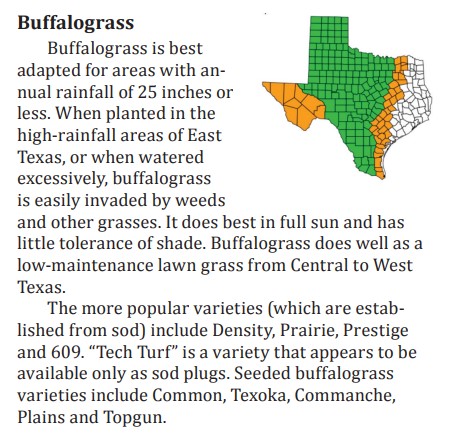By David Wall, Mount Pleasant Master Gardener
Almost every year about this time, people start asking whether they should try buffalo grass (Bouteloua dactyloides). It’s a warm season grass that does well with little to no maintenance and has relatively little water requirements once established. Until then, it takes as much water as most other lawn grasses. It can be laid down as seed (not recommended) or sod, but it spreads by stolons, which are above ground stems. Wherever stolons touch soil, they form new roots, resulting in a much denser turf. It won’t tolerate heavy shade for more than 1/2 a day and doesn’t like heavy, constant foot traffic.

Established buffalo grass requires little water and can literally survive without irrigation, although under such conditions, it’ll go dormant, leaving the ground open to weed invasions while dormant. It’s usually the last grass to go green in the spring (early May), and the first to move into fall dormancy in September, although newer cultivars extend the growing period.
Historically, buffalo grass hasn’t been recommended around here, and even today, the problem with choosing buffalo grass is making sure you have the correct cultivar for a lawn. Some of the cultivars are best suited for areas other than lawns.
Native buffalo grass has a natural height of about 5 inches, which is too tall for a yard lawn. Mowing it at a height of 2-3 inches will almost certainly reduce the density enough so weeds can invade.
Lawn-acceptable varieties include Bison, Top Gun, Cody (perhaps the best one), and Plains. Whether you can buy sod in your area is debatable, but if you have to go with plugs, the time to become established and dominant will increase, although stolon spreading is fairly fast.
The literature suggests that other cultivars, such as Texoka and Sharp are best left to rangeland and pastures.








